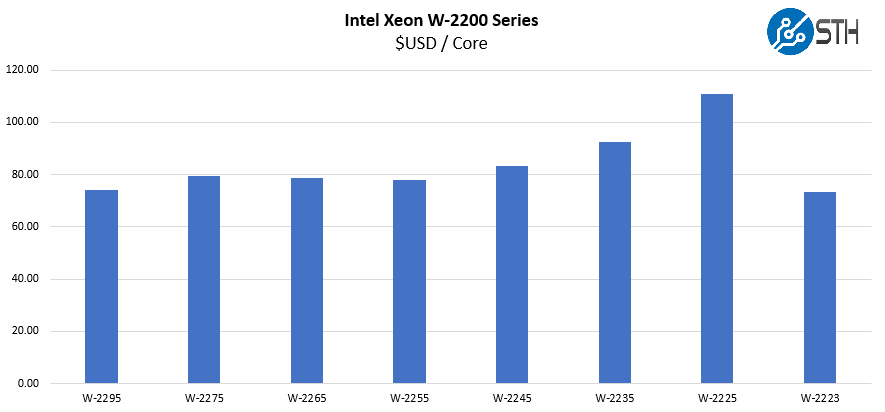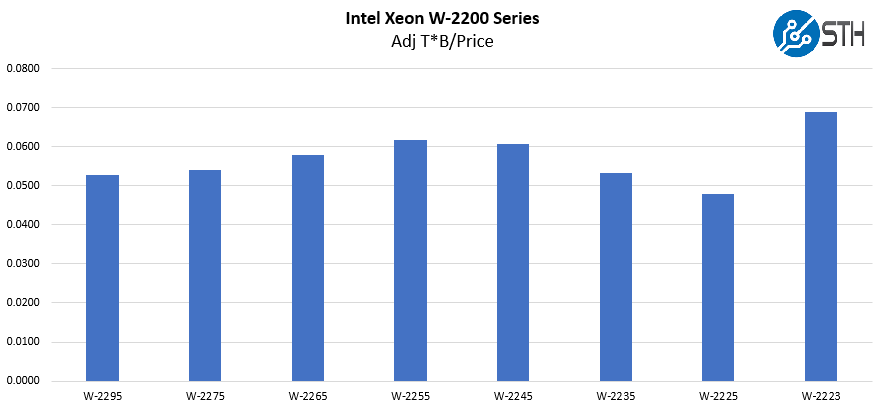Power Consumption
We tested the Intel Xeon W-2295 in the Puget Systems workstation configuration on 120V power at 21C using our Extech TrueRMS power meter. Here is what we saw:
- Standby: 7w
- OS Idle: 131W
- 70% Load: 228W
- 100% Load: 255W
- Max: 287W
Overall, this was gentle on the power side compared to many of the chips we have seen recently. Although this is the higher-end of the Xeon W-2200 range, there are now several options for higher power parts available from Intel and AMD which makes this relatively lower-power.
Intel Xeon W-2295 Market Positioning
Thes chips are not released in a vacuum instead, they have competition on both the Intel and AMD sides. When you purchase a server and select a CPU, it is important to see the value of a platform versus its competitors.
Intel Xeon W-2295 v. Intel Alternatives
Competition in the SKU stack comes in a number of forms. Here is a chart from our Intel Xeon W-2200 Series Launch SKUs and Value Analysis piece. As you can see, Intel has a different pricing methodology with these parts than it does with the Xeon Scalable line.

When we look at the above competition with the Xeon W-2200 series on a straight cost-per-core basis, the Intel Xeon W-2295 is a halo part that is actually discounted on a cost-per-core basis versus its stablemates.

Even adding threads and frequency into the mix, we see that the Intel Xeon W-2295 may actually be the best value in the line, despite being a halo part.

There is more competition in the Intel stack than just Xeon W-2200 series processors. If you need lower amounts of RAM, memory bandwidth, cores, and PCIe, then the Intel Xeon E-2288G is an interesting option. At that point, you need a different class of system.
As a direct alternative, the Intel Core i9-10980XE is a very similar processor. One buys the Xeon W-2295 for features such as four times the RAM support and ECC memory support. One buys the Core i9-10980XE unless the Xeon’s features are necessary. Intel needs to stop with their ECC segmentation for Core and Xeon. Even lowly Intel Core i3 CPUs have ECC memory support and AMD has ECC UDIMMs support. These are good chips, but the product segmentation needs a refresh for the 2020s.
The higher-end Intel Xeon W-3275 makes a strong case as being the next major step up from this line. We wish Intel would add DCPMM support to the Xeon W series and give the chips an enormous differentiator in the market.
Perhaps the most intriguing competition now comes from the 2nd Gen Intel Xeon Scalable Refresh CPUs. In this price range, we have chips like the Xeon Gold 5218R, Gold 5220R, and Gold 6226R. Those are all dual socket capable chips that support Intel Optane DCPMM and range from 16-24 cores. While they are not hitting the same single-thread speeds, they can potentially offer more cores at a similar price point and then scale to two chips per system lowering system costs even further.
Intel Xeon W-2295 v. AMD Alternatives
This is a very tough comparison at the moment. AMD has a more modern architecture on a more modern process. AMD is also using extremely aggressive pricing. While the Xeon W-2295 can hit higher clock speeds, the AMD Ryzen Threadripper 3960X has 33% more cores, about 5x the L3 cache, more PCIe lanes, and PCIe Gen4 support. While the Core i9-10980X was a significantly lower cost part, the Xeon W-2295 is priced directly in this range. Effectively, one buys the Xeon W-2295 over the Threadripper 3960X if they need more than 256GB of memory support, Intel specific features, or the W-2295 is better for licensing.
The AMD EPYC 7402P is perhaps the most fascinating comparison, even beyond what the Threadripper series offers. Although we would suggest Threadripper over EPYC “Rome” for workstations as we discussed in AMD EPYC 7002 Rome v Threadripper for Workstations, there is a segment of the market that wants solid CPU, but also more expandability. For that segment, the AMD EPYC 7402P now offers a very unique alternative to the Xeon W-2295.
Final Words
What is clear is that the Intel Xeon W-2295 performs well, and is an enormous upgrade over the Xeon E-2200 line. It also has perhaps one of the best pricing models of any recent top-bin part in an Intel Xeon series. At the same time, it is in the unenvious position of being besieged as a mid-range part in today’s market.
There is now a market dynamic that simply did not exist a few years ago. Direct competitors to the Xeon W-2295 include parts such as the less expensive Core i9-10980XE, the AMD Ryzen Threadripper 3960X, EPYC 7402P, and no less than three Xeon Gold “R” SKUs along with the existing Xeon “U” single socket parts. We mentioned this in our Xeon Scalable Refresh piece, but we think that the Xeon W-2295 is a part impacted by the refresh and Intel needs to adjust its pricing to compete better with AMD and other Intel offerings.
Using the Intel Xeon W-2295 one will have a great experience either in a workstation or in a server. 18 higher-frequency cores ensure that is the case. If the chip offers the right level of expandability and features for your application, it is absolutely a great part. On the other hand, if you need a different feature set, one would be wise to survey alternatives as AMD and Intel now have so many offerings in the $1000-$1600 price bracket making it an extremely crowded space for the Xeon W-2295 to play in. At $975-$1050 it would be much more competitive but that is a delta Intel can easily bridge with discounts to systems builders.




Nice setup.
I would have been even nicer when the 3950x with a TDP of 105 Watt and the 3960x in ECO-MODE (~ 125 Watt and a performance decrease ~ 25%), would have been mentioned. It’s good to see that the competition between Intel and AMD brings us a lot, let’s hope we will see the same competition in the near future between NVidia and AMD (and all the ARM, RISC-V, etc.. processors).
Good busy times for STH and the community.
John, thanks a lot for this article. Was looking forward to be reading it for weeks already. Anyway, let me ask one question. You mention “For our 2nd Generation Intel Xeon Scalable CPU quad-socket reviews, we are using the following configuration:” — which looks like a template edit from some other article, which actually lead me to the question (if you have used different article as a basis): are you 100% sure about your power figures? I mean 131W OS idle is way much than what I would expect from the system. For example look into William’s article about i9-10980xe https://www.servethehome.com/intel-core-i9-10980xe-review-18-cores-of-pure-intel/6/ — idle power consumption is 71W! That’s something I would also expect from W-2295. So your 131W really surprises me a lot. Thanks for checking!
Also Misha’s comment brings up a good idea for a potential article – looking at the configurable TDP options of the threadripper chips (Should be noted that the IO die consumes a huge amount of power and this goes up as you use higher speed memory, so as you configure the TDP down, the all-core cpu performance discrepancy will rise.
Your conclusion is spot on. Intel needs this to be a $999 price part.
I don’t agree that the 3950X is a real competitor. It doesn’t have as many PCIe lanes. Gen4 is nice, but having more connectivity matters. I would’ve liked to have seen it in the review too, but I understand why it’s not there.
KarelG – That is what the number was. I agree it is higher but the test configurations are different so what can I say? We have a range of values here just to give some sense. At $0.20kWh power that’s $100 a year difference. I will gladly pay $100 a year more for components that are virtually silent. These are not sub $1000 systems so a higher idle load does not turn me off. I know that is simplistic, but the system itself was really nice even if idle power was higher than other configurations.
@Nate77
Same is valid for the Threadripper and the EPYC, they have more or way more PCIe lanes with way more bandwidth.
When looking at the test setup.
we are using the following configuration:
CPU: Intel Xeon W-2295
Motherboard: Asus WS C422 SAGE/10G
Ram: Crucial 128GB DDR4-2666 REG ECC (4x32GB)
Video Card: PNY GeForce RTX 2080 TI 11GB Blower Fan
Chassis: Fractal Design Define R6 USB-C Black
Power Supply: EVGA SuperNOVA 1000W P2 Power Supply
CPU Cooling: Corsair Hydro Series H60 CPU Cooler (Rev. 3)
It’s no problem to make a similar configuration with Ryzen, Threadripper or EPYC. STH has made enough side notes about the amount of memory, PCIe-lanes, etc.. and what you need when you want to do something with your setup.
John — thanks for confirmation. No offense, I’m just curious what the heck was that power hungry in the system in idle load since well, I cannot help, but still think CPU is not the culprit here.
Otherwise system was excellent and if I read your graphs right then even less consuming than W-2123 or a bit higher up to the 1950x territory and this is nice (graphs from Williams’ i9-10980xe article).
BTW: you have not mentioned drive(s) used in the configuration in the configuration paragraph, but I guess they don’t make that much difference…
Can you even buy the 10980xe anywhere? I see it listed for far higher prices than MSRP, comparable to this xeon, and it’s not even in stock then.
The product exists almost purely on Paper to make the Lineup look better to the shareholders.
If this xeon is actually available, that’s a huge step up for intel products.
Hi!i heard about the Intel xeon w-2295.it uses the lga socket2066. Mye pc has a lga socket2066. Can i upgrade to this processor?i have a I9-9900x processor.
Hi Farshad, you can upgrade to the 2295, however if you don’t absolutely need ECC, it would be wiser to wait until the 10980xe is back in stock, and if you don’t need AVX-512, AMD would be the smarter choice since they will provide an upgrade path over the next few years.
Great job, STH!
I do appreciate the work you are doing!
You are becoming one of my favorite site.
May I ask a wish?
I work in simulation field (FEA/CFD).
REQUEST
1) Could you run also the SPECworkstation benchmark as you did for 3960x/3970x/10980xe?
In particular, the Product Development.
2) Could you perform the benchmarks also with AVX-512 on? Just to see where this kind of instructions can influence the performance. Sometimes, Intel CPUs outperform AMD ones, even they have less core… Really interested in which cases (while waiting for Zen3 and their AVX-512 implementation).
Thanks
The missing link is the Linpack benchmarks – I can’t buy a Xeon workstation without seen the GFLOPS it can deliver.
BTW the W-2295 would have scored much closer to the 10980XE if 2933MT/s memory had been used. I discovered that it will continue to run at 2933MT/s with 2 DIMMs per channel if you use DDR4-3200R automatically derating to DDR4-2933R when loaded with 2DPC. The higher spec memory can then be leveraged at full-speed on a future W-3300 upgrade running 8 memory channels down the road.